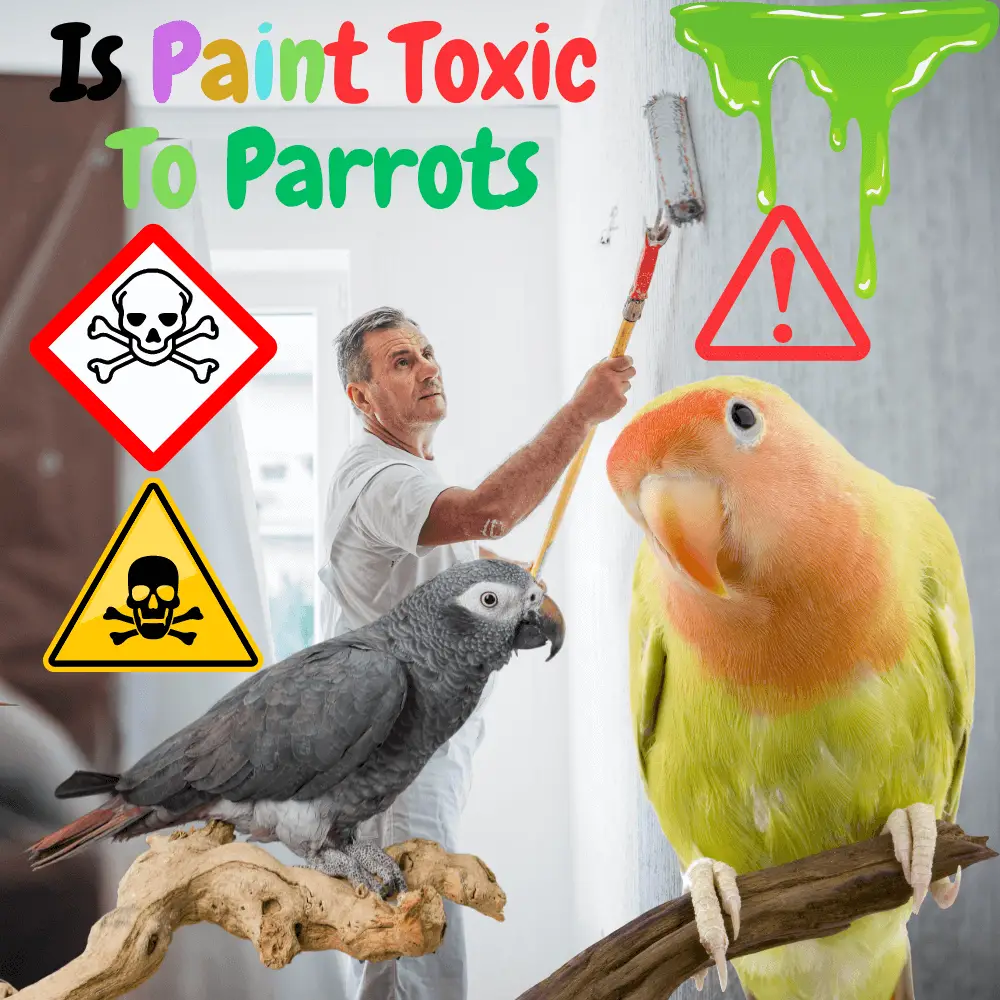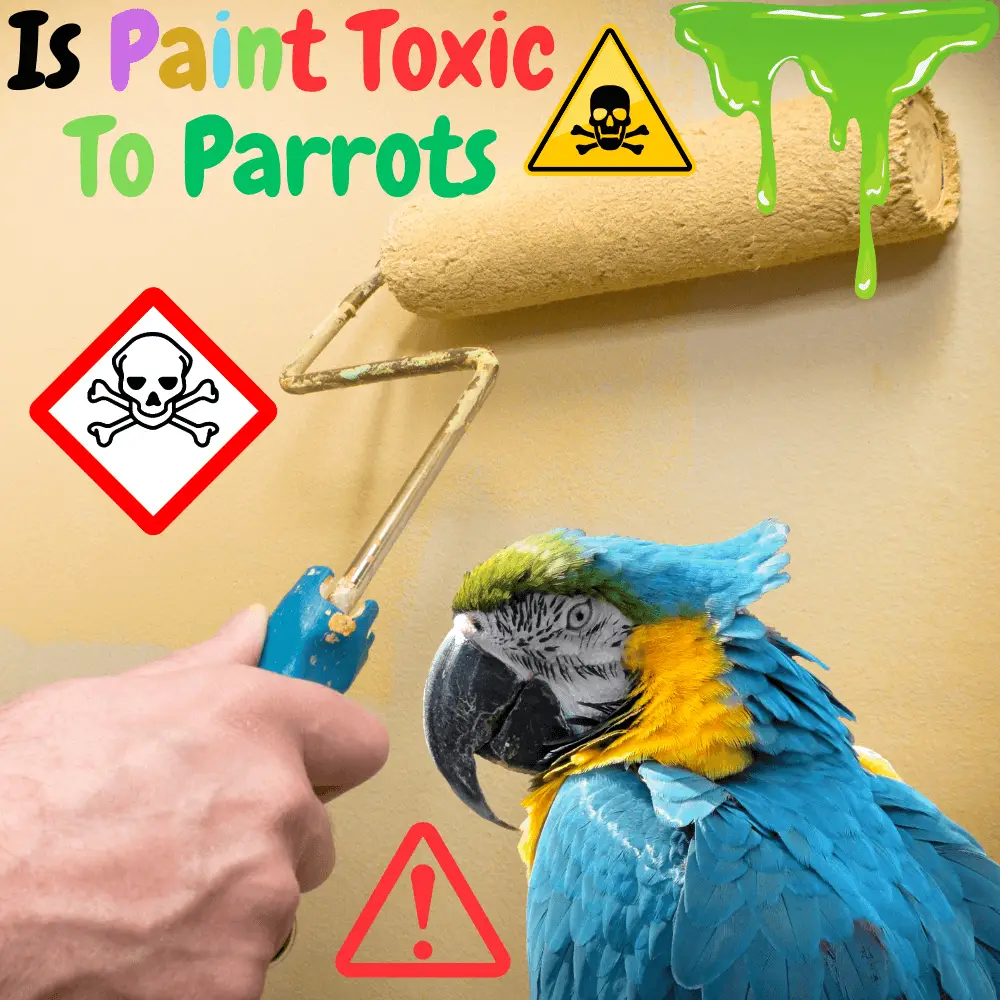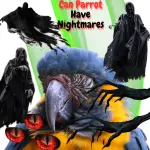Safe Paint for Parrots: Painting your home can be a difficult task if you have a parrot. These birds are curious and can fly on damp walls or surfaces or swallow paint. In addition, you will need to make sure that the fumes and vapors will not be a novice for your parrot.
Whether used for decoration or recreation, many paints contain dangerous compounds that are toxic to parrots. If you need to paint your house or birdcage, temporarily relocate your parrot until the paint is dry and the room is airy. Once dry, acrylic-based or spray-based paints are safe for parrots. Avoid latex paint, which is deadly in its fumes.
Parrots live a long time, so you will not be able to avoid painting throughout the life of your pet bird. Therefore, you need to tackle a DIY project safely. Paint and parrots don’t mix, but you can safely paint your home.
Is the paint safe for parrots?
Most of the paints you buy in a DIY store are deadly to a parrot if ingested. The biggest problem is a cocktail of different components, including zinc, formaldehyde, and lead (although in France are used is banned since the early 50s, but not in all countries…).
The parrot or parakeet should be kept away from paint for a minimum of 2 weeks after application. This is the only way to ensure that your parrot is not exposed to harmful chemicals. Even then, you will need to use proper paint.
You will need a second home for your parrot before attempting a rejuvenation or paint-based creation project. Ideally, move your parrot to another house. If this is not possible, place your parrot’s cage in another room until at least a week – ideally two – after the end of the project.
Peck and nibbling on dry paint is less likely to make parrots sick. Once the paint has dried on a surface, the hazardous components are no longer active. The fresher the paint, and the more recently it has been opened, the more dangerous it will be for your parrot.
Unfortunately, parrots can still peck and bite the paint. There are many reasons for this, including boredom, the desire to escape from the cage, curiosity, and the search for more calcium. Provide your parrot with an attractive environment.
Are paint fumes bad for parrots?
If you keep your parrot away from wet surfaces, many different paints contain volatile organic compounds. These create the fumes associated with paints, many of which are toxic to your parrot.
VOCs are organic chemicals that turn into vapor when exposed to standard room temperature. The term “volatile” refers to the fact that these chemicals have an extremely low boiling point and quickly disperse into the air, letting your parrot breathe them in.
Not all VOCs are toxic for parrots and parakeets. For example, olfactory behaviors that result in the release of pheromones are considered a natural use of VOCs. As the American Journal of Plant Sciences explains, many edible plants also release VOCs.
Unfortunately, just as many VOCs are dangerous. Those found in paintings are often deadly to our feathered companions. To be able to fly, parrots have extremely efficient airways. It also means that any toxin breathed into the atmosphere quickly spreads through the body.
Today you will find a range of low and VCO-free paints on sale. If you have a parrot, only the parrot will do. Even then, consider investing in an air quality monitoring device. Reintroduce your parrot only in a bright and well-ventilated room for several days.

Are interior paints safe for birds?
If we are honest, no product can be considered a paint 100% suitable for birds. All products are dangerous for parrots when wet. However, some types of paint are better than others.
Always look for paint with the following labels: NF Environment, European Ecolabel, and Excell. This means that the product has been deemed safe for humans and the environment. This does not automatically mean that it is suitable for parrots, but it is a step in the right direction.
As we said, you’ll still need to look a little more into the paint you want to use. Let’s take a look at the most popular paints available on the market and their suitability for parrots:
Acrylic paint
Most bird experts recommend acrylic paints if you need to use such materials. This is because acrylic paints do not emit any odor in the air, which means that there are no harmful fumes.
Acrylic paints are versatile, making them useful for any homeowner. For example, if you need to touch up or redecorate a cage, acrylic is just as beneficial as applying larger layers to larger surfaces.
Ceramic paint
Many people like to paint ceramics as a hobby. Parrot owners, in particular, may seek to decorate food or water dishes in a bird cage. This hobby, however, requires special paintings – simple watercolors or oil paintings will not suffice.
Fortunately, most ceramic paints are acrylic-based. This means that you will need to take the same precautions as above. Allow the paint to dry before reapplying decorated ceramics to a cage, and check the label of any paint for dangerous components before buying.
Latex paint
Latex paint fumes and parrots don’t mix. Therefore, you should never use latex paint if you have a pet bird. More than any other type of paint, latex paint is full of VOCs. Even water-based latex paint should be avoided.
This may seem confusing, as latex is a popular material for parrots’ toys and perches. This is due to the flexibility offered by this material. The difference here, of course, is that a latex toy for example is completely dry. This means that there is no risk of VOCs.
However, some cheap latex materials have a distinct smell. In these cases, it is best to keep them away from your parrot. The paint may be of inferior quality and susceptible to peeling, increasing the risk of toxicity.
Milk or casein paint
Milk paint sounds unappetizing, but it’s an odorless, VOC-free alternative to traditional paints. Many people use milk paint to meet decorative needs without causing risks to the environment.
The product is not made from milk as we know it. Instead, casein – a protein found in milk – forms the base, along with lime. This means that milk paint should still be kept away from parrots, which have trouble digesting dairy products.
The reason for this is that all parrots or parakeets are mostly lactose intolerant. On paper, milk paint does not contain this ingredient – it is a sugar found in dairy products, while casein is, as we said, a protein. However, traces of lactose may remain, leading to gastric disorders.
Oil painting
Oil paints give off significant fumes that are harmful to birds, so these materials should be kept away from parrots. It’s possible to find oil paints that declare themselves non-toxic (potentially made from flaxseed), but it’s still not worth taking a significant risk.
If you like to use oil paints for art, do it away from your parrot. If this must be done in the house, settle into an art studio where your parrot will never venture. Also, never leave a canvas or other material created with oil paint in plain sight until it is completely dry.
Watercolor painting
If you want to apply a new color to a cage, watercolors are the closest thing to bird-safe wood paint. This does not mean that your parrot can interact directly with the paintings. Watercolors dry quickly, do not emit fumes, and contain fewer dangerous ingredients.
Watercolors are also commonly associated with amateur painting. If you like to create artwork, do it in a separate room from your parrot’s. Better yet, finish any painting — and store all the paintings — outside the house.
Parrots are attracted to bright colors. Since watercolors are available in many shades and shades, a bird may become curious and start pecking at paint cans.
What happens if a parrot eats paint?
We have been careful to clarify that parrots should never consume or inhale paint. Such an event rarely ends well. Can we always be sure that a bird has been in contact with wet paint?
Don’t just rely on catching your parrot in the act, and don’t wait until you notice a paint-stained spout. Instead, watch for any warning signs of toxicity in your pet. These signs include:
- Diarrhea and vomiting
- Difficulty breathing
- Lethargy and depression
- Convulsions and seizures
- Blood in the stool
If you spot these symptoms, immediately ventilate a room and call a veterinarian who specializes in birds. Your bird will need urgent medical attention, as consuming or inhaling untreated paint is often fatal.
Our last tip: Protect your parrots from paintings!
After establishing that parrots should be kept away from paintings, you want to ensure the safety of your parrot. Although parrots can have a strong will and find problems, let’s remember the measures to take to ensure the safety of your parrot:
- Use water-based paint instead of oil paint.
- Use only VOC-free paints and never use products containing heavy metals (zinc, lead, etc.).
- Apply paint when your parrot is not in the room (or, better yet, in the house).
- Open the windows (while the cage is closed) before returning the parrot, in order to ventilate the room completely.
- Get an air quality meter and make sure the atmosphere is free of VOCs.
- Make sure all paints are completely dry to the touch
- Store the paint in a safe place, away from any potential interaction with your parrot.
If you follow these basic guidelines, there’s no reason for your parrot to be poisoned by paint. If you can’t commit to taking these safety precautions, consider avoiding painting altogether. Wallpaper is a safer option.
If you have a parrot, assume that any paint can harm your pet. If you need to apply a fresh coat of paint to your home, take the necessary steps to protect your parrot.
Always adopt an attitude focused on prevention and safety, keeping the paint and the parrot as far away from each other as possible…






















